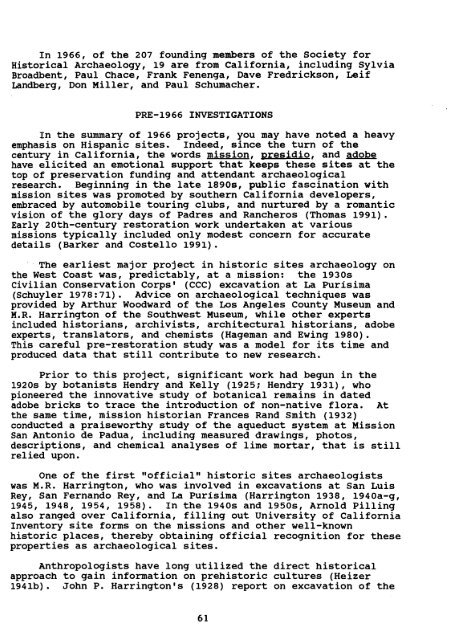SOME OBSERVATIONS ON THE DEVELOPMENT OF HISTORICAL ...
SOME OBSERVATIONS ON THE DEVELOPMENT OF HISTORICAL ...
SOME OBSERVATIONS ON THE DEVELOPMENT OF HISTORICAL ...
You also want an ePaper? Increase the reach of your titles
YUMPU automatically turns print PDFs into web optimized ePapers that Google loves.
In 1966, of the 207 founding members of the Society for<br />
Historical Archaeology, 19 are from California, including Sylvia<br />
Broadbent, Paul Chace, Frank Fenenga, Dave Fredrickson, Leif<br />
Landberg, Don Miller, and Paul Schumacher.<br />
PRE-1966 INVESTIGATI<strong>ON</strong>S<br />
In the summary of 1966 projects, you may have noted a heavy<br />
emphasis on Hispanic sites. Indeed, since the turn of the<br />
century in California, the words mission, presidio, and adobe<br />
have elicited an emotional support that keeps these sites at the<br />
top of preservation funding and attendant archaeological<br />
research. Beginning in the late 1890s, public fascination with<br />
mission sites was promoted by southern California developers,<br />
embraced by automobile touring clubs, and nurtured by a romantic<br />
vision of the glory days of Padres and Rancheros (Thomas 1991).<br />
Early 20th-century restoration work undertaken at various<br />
missions typically included only modest concern for accurate<br />
details (Barker and Costello 1991) .<br />
The earliest major project in historic sites archaeology on<br />
the west Coast was, predictably, at a mission: the 1930s<br />
Civilian Conservation Corps' (CCC) excavation at La Purisima<br />
(Schuyler 1978:71). Advice on archaeological techniques was<br />
provided by Arthur Woodward of the Los Angeles County Museum and<br />
M.R. Harrington of the Southwest Museum, while other experts<br />
included historians, archivists, architectural historians, adobe<br />
experts, translators, and chemists (Hageman and Ewing 1980).<br />
This careful pre-restoration study was a model for its time and<br />
produced data that still contribute to new research.<br />
Prior to this project, significant work had begun in the<br />
1920s by botanists Hendry and Kelly (1925; Hendry 1931), who<br />
pioneered the innovative study of botanical remains in dated<br />
adobe bricks to trace the introduction of non-native flora. At<br />
the same time, mission historian Frances Rand smith (1932)<br />
conducted a praiseworthy study of the aqueduct system at Mission<br />
San Antonio de Padua, including measured drawings, photos,<br />
descriptions, and chemical analyses of lime mortar, that is still<br />
relied upon.<br />
One of the first "official" historic sites archaeologists<br />
was M.R. Harrington, who was involved in excavations at San Luis<br />
Rey, San Fernando Rey, and La Purisima (Harrington 1938, 1940a-g,<br />
1945, 1948, 1954, 1958). In the 1940s and 1950s, Arnold Pilling<br />
also ranged over California, filling out University of California<br />
Inventory site forms on the missions and other well-known<br />
historic places, thereby obtaining official recognition for these<br />
properties as archaeological sites.<br />
Anthropologists have long utilized the direct historical<br />
approach to gain information on prehistoric cultures (Heizer<br />
1941b). John P. Harrington's (1928) report on excavation of the<br />
61
















